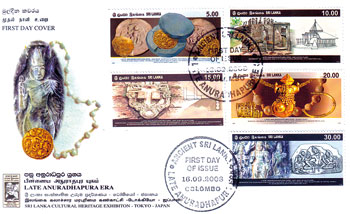Late Anuradhapura period which refers to the latter part of when ancient Sinhala kings ruled from Anuradhapura, was a somewhat chaotic period with repeated
South Indian invasions and
internal revolts. The
administration was
naturally weak with such problems. Yet whenever there was peace in between, arts and crafts, architecture and irrigation flourished.
A significant feature was the high standards reached in these activities.
During this period,
brick and stone replaced timber which had been used extensively earlier. New architectural features were created. The image houses were more creative.
The pinnacle became a feature of the stupa. The
construction of stone
fences around stupas
(as in Thuparama) and the 'bodhi' (Bo tree symbolising the enlightenment of the Buddha under a tree) also was begun during this period. These were more ornamental as seen in Medirigiriya vatada-ge
(featured in Rs. 10 stamp along with an architectural drawing of the 'vatada-ge') and Tiriyaya vatada-ge.
The growth of Mahayana Buddhism was another feature during this period. Mahayana influence was seen when Bodhisatva images depicting the
personality of the Buddha prior to becoming the Buddha began to appear. These ranged from mini metal statues to
colossal stone images as seen at Buduruvagala. The Bodhisatva Vajrapani and Avalokiteshvara at Buduruvagala can be seen in the Rs. 30 stamp which also depicts the royal family at Isurumuniya.
The exquisite carvings seen in Anuradhapura
like the moonstone
(sandakadapahana), guard stones (mura-gal) at the entrances to an image house, and dwarf stones all belong to this period. These works of art show the influence of the Indian craftsmen of the Gupta and Pallava schools. The famous Isurumuniya lovers are a good example.
Wall paintings of this period (5th – 11th century) have been found at
several places like Pulligoda, Mahiyangana relic chamber and Situlpawwa.
The usage of currency had been prevalent
during this period. Gold coins (ran kahavanu) as well as other types of coins of lesser weight had been in use. 'Ran kahavanu' had been in usage during the period 8 – 11th century.
These have been excavated in several places. Those found at excavations in and around Abhayagiri
vihara in Anuradhapura are unique. Ruins of a
factory had been found to the east of the alms-hall at Abhayagiriya. Clay moulds used to cast coins belonging to the 9th century have also been found. These have two lids and a tiny opening in the form of a funnel to pour melted gold into the coin moulds.
Five gold plaques and 22 gold coins have been unearthed at this
location. Belonging to the 8th and 9th centuries, these coins had their weights marked in Sinhala
characters. 'Ekasiyadekalandai'
(102 'kalandas') is what is marked on the largest coin.
A gold coin, its mould and a gold ingot used for manufacturing coins are featured in the Rs. 5 stamp.
There is also evidence of the use of jewellery extensively during this period. Jewellery has been unearthed during the Jetavana and Abhayagiri excavations. Among the finds at Abhayagiriya was a metal container in the shape of a mango with a whole heap of unfinished gold articles of a jewellery manufacturer.
Gold chains and a gold bangle have also been found. In addition, gold beads, clay beads and glass beads as well as those made out of other material have been among the
excavations.
The Rs. 20 stamp
features a bangle, a
necklace with a pendant, and an ornamental anklet. The fine and delicate
carvings depict the
excellent creative skill of the sculptor. The necklace is made of gold thread and is adorned with clay beads.
Irrigation technology reached high levels during this period. Gangatalawewa (now referred to as Kantale tank), Giritala Vapi or Giritale tank, Enderagala wewa were constructed by King Aggabodhi II
(571 – 604 AD).
Most other kings
renovated tanks which had been ruined during the troubled times. It had been recorded that these renovations by King Mahinda IV (956 – 972 AD) helped to overcome a famine.
Attention paid to health and sanitation has been very high during this time.
Of special interest is the 'Jantagara' providing
hot water bathing
facilities to the elderly and ailing monks. In addition to monks’ dwelling places in Anuradhapura, this facility is seen in Ritigala, Arankele and Heththikuchchi vihara complexes. Grinding stones to grind medicinal items had also been provided.
Eco-friendly systems
had been in existence
relating top sanitary needs. Urinals and latrines were separately maintained. The urinal system provided for the released urine to flow through a set of pots placed one on top of the other and the filtered urine to go directly into a deeper layer of soil as purified water.
The urinal stone
excavated from the Western monastery in Anuradhapura is seen in the Rs. 15 stamp along with a cross section of the sanitary system. |


